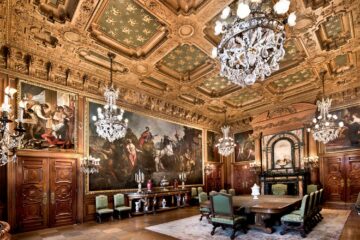Sheer and Glowing in Las Vegas
Step inside the Neon Museum in Las Vegas, where a vast collection of bright signs — an art form that’s synonymous with the city — offer a window into the city’s one-of-a-kind history.
Las Vegas has given us one more reason to be obsessed with it (as if we needed it). As it turns out, the stimulation capital of the world has a heart, and it exists in the form of the Neon Museum. This two-acre property in the city’s centre is the final resting place of Las Vegas’s most historic and cherished neon signs, those pillars of excitement that lit the famed streets for decades — and, for many of them, even longer.
There are three parts to the Neon Museum: first, there’s the Neon Boneyard, an outdoor space that houses these glowing artifacts. Then there’s the visitors’ centre, which is, fittingly, nestled inside the lobby of the old La Concha Motel; and finally, there’s the Neon Boneyard Museum Gallery, a separate outdoor exhibition space dedicated to educational programs and workshops, photo shoots and the like.
To walk through the grounds of the Neon Museum is to flip through the pages of the city’s very famous past, from the lovably raunchy years to the gawky-glamorous ones. The non-profit attraction has only been around for three years, but the museum has already found its place atop every tourist’s list of must-sees, and this year alone it’s seen over 85,000 visitors flood through its gates. Even the locals are fascinated by the quirky reservoir of a preserved Las Vegas, which exists not only to pay homage to these pieces of the past, but to keep them looking sharp.
“Any time Las Vegas says goodbye to a property, a piece of the city’s landscape and a visual marker of its history disappears,” says Danielle Kelly, executive director of the museum. “The Neon Museum’s collection ensures the preservation of at least one beautiful fragment of this history, so its story may be shared with others.”
This past May, Las Vegas lost one of its last remaining original landmarks, the circa-1955 Riviera Hotel and Casino — the boulevard’s first high-rise. The place had hosted performances by everyone from Elvis Presley to Amy Schumer, from Dean Martin to Steve Martin, and it made appearances in an array of blockbusters (Ocean’s Eleven, Casino, 21 and The Hangover among them). The place was a historic shrine to that impossible mix of flashiness and elegance that only Vegas can pull off, and it broke the hearts of city natives and visitors alike to see it disappear from the strip. And that’s where the Neon Museum stepped in. The most important piece of the Riviera was its massive crimson sign, a symbol of the city’s past that no one wanted to have to say goodbye to.
Like an exhausted book lover retiring her favourite edition to the library for safekeeping, the Riviera’s owners donated a few pieces of its signage to the Neon Museum in July, including the iconic red sign that had sat on its exterior for over half a century. The relic has, of course, found its new home in the Boneyard — right above the historic Stardust sign, which itself was acquired from its respective hotel when it shut its doors in 2006.
“So many people mourned the loss of the Riviera, and found comfort in sharing stories with us and photos of wonderful memories,” says Kelly. “The Riviera is one of the last icons of the legendary strip, but now for us it can be a new icon of how we might embrace the future while celebrating the past.”
As the Riviera sign joins the museum’s 200-plus pieces of a Vegas long gone, Kelly says there’s only more excitement in store for the museum, including its annual Halloween birthday party, the “Boneyard Bash.”
Whether you go to gamble or to see the sights, next time you find yourself wandering through the city of sin, pay a visit to its labyrinth of neon ghosts.
photos by Vox Solid Communications



















































































No Comment